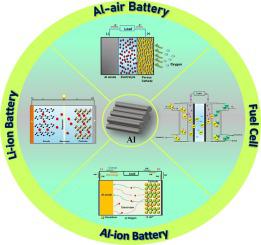当前位置:
X-MOL 学术
›
Prog. Mater. Sci.
›
论文详情
Our official English website, www.x-mol.net, welcomes your
feedback! (Note: you will need to create a separate account there.)
Aluminium alloys and composites for electrochemical energy systems
Progress in Materials Science ( IF 33.6 ) Pub Date : 2024-05-31 , DOI: 10.1016/j.pmatsci.2024.101322 Muhammad Manikkoth , Sreekala Kunhi Kannan , J. Mary Gladis , T.P.D. Rajan
Progress in Materials Science ( IF 33.6 ) Pub Date : 2024-05-31 , DOI: 10.1016/j.pmatsci.2024.101322 Muhammad Manikkoth , Sreekala Kunhi Kannan , J. Mary Gladis , T.P.D. Rajan

|
Affordable and clean energy stands as a key component within the realm of sustainable development. As an integral stride toward sustainability, substantial endeavors have been dedicated to advancing electrochemical energy technologies aiming to improve energy efficiency. Al is the third most element in the earth’s crust, finds extensive applications in various electrochemical energy systems. The volumetric capacity of Al (8046 mAh/cm) is fourfold higher than that of Li (2042 mAh/cm). In addition, the advantages of low cost, safety and environmental friendliness spurred widespread interest in utilizing Al-based alloys, composites, and nanostructured materials to create highly efficient electrodes for electrochemical energy storage systems. Despite its potential, Al-based materials face challenges such as passive oxide layer formation, self-corrosion and compatibility issues with electrolytes leading to low energy and power density, hindering the commercialization of Al-based technologies. This review concentrates on the pivotal role of Al-based materials across various electrochemical platforms such as supercapacitors, fuel cells, and batteries, particularly highlighting Al-air and Al-ion batteries. It explores charge storage mechanisms, methodologies, and the impact of nanostructures on electrochemical reactions. Additionally, it addresses the pertinent challenges associated with recently developed electrode materials and provides future directions for enhancing electrochemical energy conversion devices.
中文翻译:

用于电化学能源系统的铝合金和复合材料
负担得起的清洁能源是可持续发展领域的关键组成部分。作为向可持续发展迈出的重要一步,人们一直致力于推进旨在提高能源效率的电化学能源技术。铝是地壳中第三大元素,在各种电化学能源系统中有着广泛的应用。 Al 的体积容量(8046 mAh/cm)是 Li 的体积容量(2042 mAh/cm)的四倍。此外,低成本、安全和环境友好的优点激发了人们对利用铝合金、复合材料和纳米结构材料制造用于电化学储能系统的高效电极的广泛兴趣。尽管具有潜力,铝基材料仍面临诸如钝化氧化层形成、自腐蚀以及与电解质的兼容性问题等挑战,导致能量和功率密度低,阻碍了铝基技术的商业化。本综述重点关注铝基材料在超级电容器、燃料电池和电池等各种电化学平台中的关键作用,特别强调铝空气和铝离子电池。它探讨了电荷存储机制、方法以及纳米结构对电化学反应的影响。此外,它还解决了与最近开发的电极材料相关的相关挑战,并为增强电化学能量转换装置提供了未来方向。
更新日期:2024-05-31
中文翻译:

用于电化学能源系统的铝合金和复合材料
负担得起的清洁能源是可持续发展领域的关键组成部分。作为向可持续发展迈出的重要一步,人们一直致力于推进旨在提高能源效率的电化学能源技术。铝是地壳中第三大元素,在各种电化学能源系统中有着广泛的应用。 Al 的体积容量(8046 mAh/cm)是 Li 的体积容量(2042 mAh/cm)的四倍。此外,低成本、安全和环境友好的优点激发了人们对利用铝合金、复合材料和纳米结构材料制造用于电化学储能系统的高效电极的广泛兴趣。尽管具有潜力,铝基材料仍面临诸如钝化氧化层形成、自腐蚀以及与电解质的兼容性问题等挑战,导致能量和功率密度低,阻碍了铝基技术的商业化。本综述重点关注铝基材料在超级电容器、燃料电池和电池等各种电化学平台中的关键作用,特别强调铝空气和铝离子电池。它探讨了电荷存储机制、方法以及纳米结构对电化学反应的影响。此外,它还解决了与最近开发的电极材料相关的相关挑战,并为增强电化学能量转换装置提供了未来方向。

















































 京公网安备 11010802027423号
京公网安备 11010802027423号